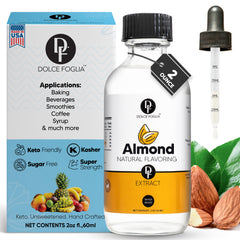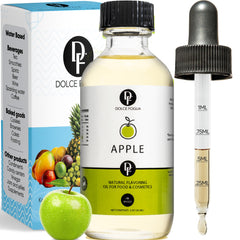
There’s a reason why blueberries are often dubbed "nature's candy." Their unique combination of sweetness and tartness, coupled with a burst of flavor in every bite, makes them a popular choice among fruit enthusiasts. But fresh blueberries aren't the only way to infuse your recipes with their vibrant taste. Enter: blueberry extract and blueberry flavoring. These concentrated versions of the beloved fruit offer a versatile and potent way to introduce that signature blueberry essence into a plethora of dishes.
What is Blueberry Extract?
Blueberry extract is derived from the blueberry fruit, capturing its essence in a concentrated form. It's created by soaking blueberries in a solvent, usually alcohol, which then extracts the natural flavors, aromas, and some beneficial nutrients of the fruit. Once the extraction process is complete, the liquid is filtered and the solvent evaporated, leaving behind the pure blueberry extract.
Is There a Blueberry Extract for Baking?
Blueberry extract serves multiple purposes. Its intense flavor makes it perfect for recipes where fresh blueberries might not be available or practical. But its use isn't limited to just culinary creations.
Culinary Delights: From pancakes, muffins, and cakes to sauces and dressings, blueberry extract adds a potent burst of flavor. It's especially useful in dishes where the moisture from fresh blueberries might affect the consistency.
Beverages: A few drops can turn a simple drink into a blueberry-flavored treat. Think cocktails, mocktails, smoothies, and even teas.
Dietary Supplements: Beyond its flavor profile, blueberry extract is rich in antioxidants, particularly anthocyanins. As such, it’s often found in health supplements.
What Do You Use Blueberry Extract For?
Yes, and in fact, blueberry extract for baking is a staple in many professional kitchens and bakeries. When you desire that robust blueberry flavor without altering the texture of your baked goods, this extract comes to the rescue. Think about cookies, for instance. While fresh blueberries could make the dough too wet, the extract introduces the flavor without changing the consistency.
Baking-specific blueberry extract is also designed to withstand the heat, ensuring that the flavor remains consistent and doesn't evaporate during the cooking process.
Is There a Blueberry Flavoring?
Absolutely! Blueberry flavoring is similar to blueberry extract but might not be derived entirely from the fruit itself. It can be a combination of natural and artificial components designed to replicate the taste of blueberries.
Blueberry flavoring is often used in confectioneries, candies, and commercial products where a consistent taste is required across large batches. It's also typically less expensive than pure blueberry extract, making it a popular choice for large-scale manufacturing.
Blueberry Muffins with Dolce Foglia Blueberry Flavoring
15 min
20-25 min
12 Muffins
Desert
Blueberry muffins have their roots in North America, where blueberries are native. Over the years, this muffin variant became an iconic breakfast staple, and with the addition of Dolce Foglia blueberry flavoring, we're adding a modern twist to this classic favorite.
Ingredients
- 2 cups all-purpose flour
- 1/2 cup granulated sugar
- 2 tsp baking powder
- 1/2 tsp baking soda
- 1/4 tsp salt
- 1/2 cup unsalted butter, melted
- 1 cup buttermilk (or regular milk with 1 tsp of vinegar)
- 1 large egg
- 1 tsp Dolce Foglia blueberry extract
- 1 cup fresh or frozen blueberries
- Optional: Crumb topping or sugar for sprinkling
Directions
Step 1
- Preheat the Oven: Begin by preheating your oven to 375°F (190°C). Line a muffin tin with paper liners or grease the cups.
Step 2
Dry Ingredients: In a large bowl, whisk together the flour, sugar, baking powder, baking soda, and salt.
Step 3
- Wet Ingredients: In another bowl, combine the melted butter, buttermilk, egg, and Dolce Foglia blueberry flavoring extract. Mix until smooth.
Step 4
- Combine Wet and Dry: Pour the wet ingredients into the dry ingredients and fold gently until the mixture is just combined. Avoid overmixing.
Step 5
- Add Blueberries: Gently fold in the blueberries.
Step 6
- Fill Muffin Cups: Scoop the batter into each muffin cup, filling them 2/3 full.
Step 7
- Bake: Bake for 20-25 minutes or until a toothpick comes out clean.
Step 8
- Cool: Let the muffins cool in the tin for 5 minutes, then transfer to a wire rack.
Unlocking Culinary Creativity with Blueberry Extract
Incorporating blueberry extract and blueberry flavoring into your recipes is a game-changer. Whether you're a professional chef, an avid home baker, or someone who just loves the taste of blueberries, these products offer a convenient and effective way to infuse your creations with that delightful blueberry essence.
As the popularity of these products continues to rise, so do the innovations in how they're used. From gourmet desserts and artisanal bread to craft beverages and even savory dishes, the possibilities are endless. The next time you're looking to elevate your culinary creations, remember that a little blueberry extract or flavoring can go a long way. Experiment, enjoy, and let your taste buds revel in the blueberry goodness!
Origin of Blueberries:
Blueberries are truly an American fruit, native to North America. The history of this vibrant berry dates back to ancient times when indigenous peoples harvested wild blueberries for sustenance. These berries, deeply rooted in the culture and folklore of Native Americans, were used not only as a food source but also for medicinal purposes and as dyes for textiles.
Legend has it that during times of famine, the Great Spirit sent these star-shaped berries (if you ever look at the bottom of a blueberry, you'll notice a perfect five-pointed star) to relieve the hunger of his children. Native Americans passed on their knowledge of the blueberry's benefits to European settlers in the early 17th century.
It was only in the early 20th century that blueberries were domesticated, thanks to the work of Elizabeth Coleman White and Frederick Coville. Before their cultivation efforts, people could only enjoy blueberries when they were in season and growing in the wild.
Today, blueberries are celebrated not just for their delicious taste but also for their health benefits. From the wild fields of ancient North America to modern kitchens worldwide, blueberries have remained a cherished fruit, evolving into various culinary delights, including the iconic blueberry muffin.





